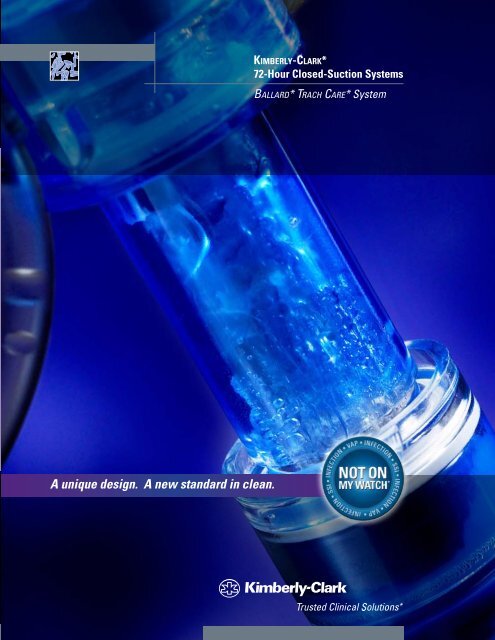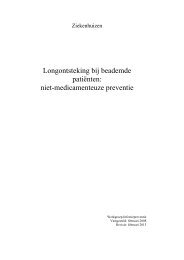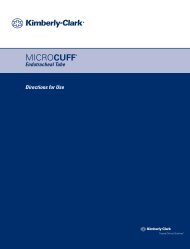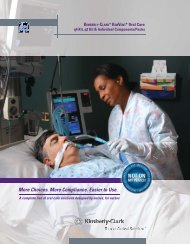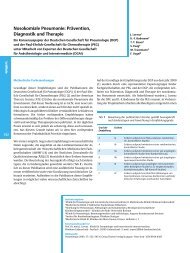Kimberly-Clark* 72-Hour Closed Suction Systems brochure - VAP
Kimberly-Clark* 72-Hour Closed Suction Systems brochure - VAP
Kimberly-Clark* 72-Hour Closed Suction Systems brochure - VAP
Create successful ePaper yourself
Turn your PDF publications into a flip-book with our unique Google optimized e-Paper software.
A unique design. A new standard in clean.<br />
Ki m b e r l y-Cl a r K*<br />
<strong>72</strong>-<strong>Hour</strong> <strong>Closed</strong>-<strong>Suction</strong> <strong>Systems</strong><br />
Ba l l a r d* Tr a c h ca r e* System
Ki m b e r l y-Cl a r K*<br />
<strong>72</strong>-<strong>Hour</strong> <strong>Closed</strong>-<strong>Suction</strong> <strong>Systems</strong><br />
Ba l l a r d* Tr a c h ca r e* System<br />
The Only System Of Its Kind With Turbulent Cleaning Action<br />
Only the Ki m b e r l y-Cl a r K* <strong>72</strong>-<strong>Hour</strong> <strong>Closed</strong>-<strong>Suction</strong> <strong>Systems</strong> with proprietary and<br />
patented “PEEP seal” technology features turbulent cleaning action that decreases<br />
bacterial colonization of the catheter tip by up to 89%, compared to standard<br />
24-hour closed-suction systems.<br />
Ki m b e r l y-Cl a r K* <strong>72</strong>-<strong>Hour</strong> <strong>Closed</strong>-<strong>Suction</strong> <strong>Systems</strong>,<br />
features and benefits:<br />
A unique cleaning chamber isolates the catheter tip,<br />
resulting in more effective cleaning, reduced peep loss,<br />
and reduced inadvertent lavage 12<br />
Turbulent cleaning action decreases bacterial colonization<br />
of the catheter tip by up to 89% over the use of a standard<br />
24-hour closed-suction system 7<br />
One-way lavage port is designed to prevent sprayback<br />
of irrigation fluids into the environment<br />
Double-Swivel Elbow provides endotracheal tube<br />
connection flexibility and less torque without extra connectors<br />
Polyurethane sleeve features improved tactile feel,<br />
allowing for easier advancement of the catheter t<br />
<strong>Closed</strong> cleaning chamber allows for<br />
automatic fluid instillation<br />
Available in Double-Swivel Elbow, T-piece, and<br />
Saline Pack configurations<br />
t Available with Double-Swivel Elbow only<br />
One-way<br />
Lavage Port<br />
designed to prevent<br />
“sprayback”<br />
Hinged Valve<br />
and “PEEP Seal”<br />
isolates<br />
catheter tip<br />
<strong>Closed</strong> Cleaning<br />
Chamber<br />
creates turbulent<br />
cleaning action,<br />
resulting in a<br />
cleaner catheter<br />
PEEP Seal<br />
helps reduce<br />
peep loss and<br />
inadvertent lavage<br />
Integrated<br />
MDI Port<br />
(where<br />
available)
Ki m b e r l y-Cl a r K* <strong>Closed</strong>-<strong>Suction</strong> <strong>Systems</strong>...<br />
A world leader in closed endotracheal suction systems.<br />
<strong>Kimberly</strong>-ClarK* <strong>Closed</strong>-<strong>Suction</strong> <strong>Systems</strong> are designed to safely suction patients on<br />
mechanical ventilation by removing secretions from the airway, while maintaining<br />
ventilation and oxygenation throughout the suctioning procedure.<br />
“Avoiding disconnection from the ventilator allows the prevention of approximately<br />
50% of the lung volume fall observed during suctioning after disconnection.” 9<br />
<strong>Closed</strong> Tracheal <strong>Suction</strong> <strong>Systems</strong> Recommended<br />
Patients who breathe solely through an artificial airway require the removal<br />
of airway secretions, and clearance is essential. 4<br />
As a best practice in the prevention of <strong>VAP</strong>, the American Association for<br />
Respiratory Care (AARC) recommends maintaining a closed ventilator circuit. 6<br />
<strong>VAP</strong> is associated with high incidence rates, mortality and costs. 1<br />
Approximately 86% of hospital-associated pneumonia is linked with mechanical ventilation 2<br />
<strong>VAP</strong> may account for up to 60% of all deaths due to Healthcare-Associated Infections (HAI) 3<br />
Approximately 8% to 28% of critical care patients develop <strong>VAP</strong> 4<br />
Each incidence of <strong>VAP</strong> is estimated to generate an increased cost of $20,000 to $40,000 3<br />
“The pathogenesis of <strong>VAP</strong>...is linked to two separate but related processes:<br />
colonization of the aerodigestive tract with pathogenic bacteria, and aspiration<br />
of contaminated secretion.” 1 –– Kollef, et al. Respiratory Care, 2005<br />
Benefits of <strong>Closed</strong>-<strong>Suction</strong> <strong>Systems</strong>:<br />
4 Removes secretions from the airway while maintaining<br />
ventilation and oxygen therapy throughout the suctioning procedure 10<br />
4 Protects the caregiver from exposure to patients’ body fluids 10<br />
4 Reducing the opportunity for contamination to occur from outside<br />
pathogens will reduce the colonization within the circuit; therefore,<br />
maintaining a closed circuit is emphasized by the AARC and others. 10
Proprietary Technology. Cleaner Catheter Tip Cleaning.<br />
As the market leader in closed-suction systems, <strong>Kimberly</strong>-Clark offers you the only<br />
closed-suction catheter on the market with proprietary features uniquely designed to<br />
reduce bacterial colonization.<br />
Cleaner is Better 10<br />
Ki mB e r l y -cl a r K* <strong>72</strong>-<strong>Hour</strong> Catheters, at <strong>72</strong> hours, show over an (89%) reduction in mean catheter<br />
tip colonization compared to the control 2210 catheters at 24 hours (p
Standard 24-<strong>Hour</strong><br />
<strong>Closed</strong>-<strong>Suction</strong> System<br />
Catheter Tip. . . after cleaning.<br />
Isolating The Catheter Tip:<br />
The <strong>Kimberly</strong>-ClarK* <strong>72</strong>-<strong>Hour</strong> <strong>Closed</strong>-<strong>Suction</strong><br />
System includes a hinged valve flap or “PEEP<br />
seal” which closes under vacuum to allow<br />
the saline vial to empty into the cathetercleaning<br />
chamber without squeezing.<br />
Ki m b e r l y-Cl a r K *<br />
<strong>72</strong>-<strong>Hour</strong> <strong>Closed</strong>-<strong>Suction</strong> <strong>Systems</strong><br />
Ba l l a r d * Tr a c h ca r e * System<br />
A B<br />
Ki m b e r l y-Cl a r K*<br />
<strong>72</strong>-<strong>Hour</strong> <strong>Closed</strong>-<strong>Suction</strong> System<br />
Catheter Tip. . . after cleaning.<br />
Turbulent cleaning<br />
action decreases<br />
bacterial colonization<br />
89%<br />
The Results:<br />
In laboratory tests, standard 24-<strong>Hour</strong><br />
catheters were cleaned by the usual<br />
method of squeezing the saline vial<br />
to dispense. A<br />
<strong>Kimberly</strong>-ClarK* <strong>72</strong>-<strong>Hour</strong> <strong>Closed</strong>-<strong>Suction</strong><br />
System catheter tip was cleaned in<br />
the isolated cleaning chamber, which<br />
prevents bacteria from re-entering the<br />
patient’s airway. B
The Ki m b e r l y-Cl a r K ad v a n t a g e *<br />
Kn o w l e d g e networK * Accredited Education<br />
Online at HAIwatch.com<br />
On-site rep-facilitated programs<br />
HAI Education Bus<br />
Ongoing Customer Support<br />
In-service training<br />
Product technical support<br />
Unsurpassed customer service<br />
Expert Sales Force<br />
Healthcare Industry Representative Credentialed<br />
On-site trained in hospitals<br />
Infection prevention website:<br />
www.HAIwatch.com<br />
Tools & Best Practices<br />
Infection Prevention Education Toolkits<br />
Product Use and Selection Tools<br />
Best Practices/ Industry Guidelines<br />
Clinical Research<br />
Staff medical professionals to advise and direct clinical research<br />
Clinical Scientific research to measure clinical outcomes in patients<br />
Peer-to-peer consultation<br />
Commitment to Excellence<br />
For more information, please call 1-800-KCHELPS in the United States or visit our web site at www.kchealthcare.com.<br />
* Registered Trademark or Trademark of <strong>Kimberly</strong>-Clark Worldwide, Inc. ©2008 KCWW. All rights reserved. H01082 H0904-08-01<br />
1 Kolleff MH. What is ventilator-associated pneumonia and why is it important? Respiratory Care. 2005 June; 50(6): 714-<strong>72</strong>4.<br />
2 Richards MJ, Edwards JR, Culver DH, Gaynes RP. Nosocomial infections in medical intensive care units in the United States. National Nosocomial<br />
Infections Surveillance System. Crit Care Med. 1999 May; 27(5):887-92.<br />
3 CDC. Guidelines for Preventing Healthcare-Associated Pneumonia, 2003. Recommendations of the CDC and the Healthcare Infection Control Practices<br />
Advisory Committee. MMWR 2004; 53 (No. RR-3).<br />
4 Chastre J, Fagon J. Ventilator-associated pneumonia. Crit Care Med. 2002; 165: 867-903.<br />
5 Rello J, Ollendorf DA, Oster G, Vera-Llonch M, Bellm L, Redman R, et al. Epidemiology and outcomes of ventilator-associated pneumonia in a large US<br />
database. Chest. 2002;122(6):2115-21.<br />
6 Hess DR KT, Mottram CD, Myers TR, Sorenson HM, Vines DL: American Association for Respiratory Care. Care of the Ventilator Circuit and Its Relation to<br />
Ventilator-Associated Pneumonia. Respir Care. 2003; 48:869-879.<br />
7 Ba l l a r d* Critical Care Products Tr a c h ca r e* <strong>72</strong> Microbiology Report. Nelson Laboratories Final Reports, Laboratory Numbers 184343, 163901.1<br />
8 Hess D. Infection Control in the Intensive Care Unit. The Role of the Ventilator Circuit. Minerva Anesthesiol 2002; 68: 356-359.<br />
9 Maggiore, M. Salvatore, Lellouche F, Pigeot J, et al: Prevention of endotracheal suctioning-induced alveolar decrecruitment in acute lung injury.<br />
American Journal of Critical Care Medicine 2003 Vol 167: pp1215-1224.<br />
10 Freytag C.C., Thies F.L, Konig W, Welte, T. Infection, Clinical and Epidemiological Society. 31-2003-No.1<br />
11 Van Hooser, T. Airway Clearance with <strong>Closed</strong>-System <strong>Suction</strong>ing. An AACN (American Association of Critical-Care Nurses)<br />
Continuing Education Publication, 2002.<br />
12 Van Hooser, T, Madsen E., Flood T. Respiratory Care. The Science Journal of the American Association for Respiration – Open Abstracts, 2002.<br />
At <strong>Kimberly</strong>-Clark, our mission is to deliver<br />
innovative healthcare solutions supported<br />
by in-service training, clinical research and<br />
accredited education that you can depend<br />
on to meet the demands of your fast-paced<br />
world. Whether your needs involve<br />
preventing healthcare-associated<br />
infections or surgical and digestive solutions,<br />
or pain management, with <strong>Kimberly</strong>-Clark<br />
you’ll always have one less worry.<br />
Healthcare-Associated<br />
Infection Solutions<br />
Surgical Solutions<br />
Digestive Health<br />
Pain Management


